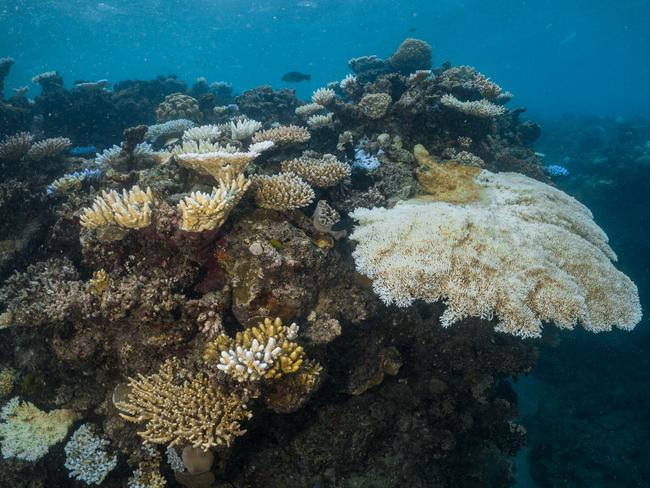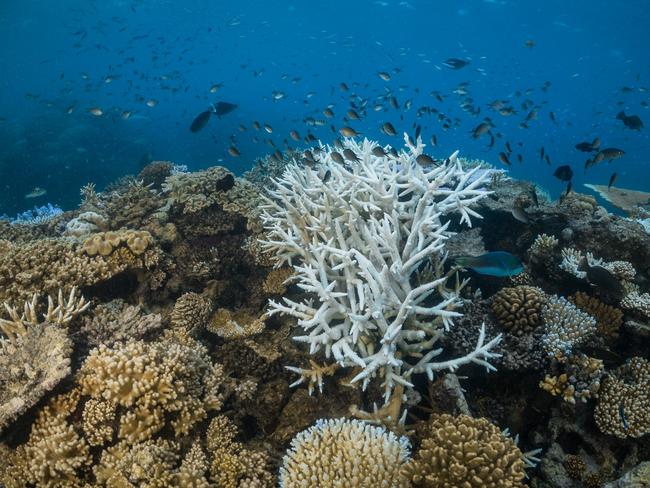Report reveals extent of Reef bleaching
After a tough summer of cyclones and marine heatwaves, a ‘summer snapshot’ has revealed the extent of bleaching on the Great Barrier Reef.
Environment
Don't miss out on the headlines from Environment. Followed categories will be added to My News.
The Great Barrier Reef experienced its sixth widespread coral bleaching event in nine years, the latest “summer snapshot” has revealed.
The report, released without fanfare online on Wednesday afternoon, paints a picture of a tough summer season for the Reef, which was impacted by marine heatwaves, Tropical Cyclone Alfred, outbreaks of crown-of-thorns starfish, freshwater inundation and coral disease.
While the reef started the 2024/25 summer with “high coral cover” there were “serious impacts” from disturbances over the following few months, the report from the Australian Institute of Marine Science [AIMS], the Great Barrier Reef Marine Park Authority [GBRMPA] and the CSIRO stated.
The full picture of the damage will not be known until August, when AIMS releases its annual Long Term Monitoring Report, but the annual “Summer snapshot” report confirmed “widespread bleaching” for the Northern and Far Northern regions of the Reef.
“While less extensive than the bleaching event in 2023–24, (this) is the second time the Reef has experienced consecutive events,” the report stated.

Of the 162 inshore and mid-shelf reefs monitored from the air, 41 per cent had medium to high bleaching, with the higher prevalence recorded on coral outcrops in waters between Cooktown and Cape York.
In the Great Barrier Reef Marine Park, about one in 11 reefs (nine per cent) had “very high” levels of bleaching, although none had prevalence that was marked “extremely high”.
Coral researchers stress that bleaching is not the same as mortality, as systems can recover after a bleaching event. But dead coral was discovered at shallow-water reefs, particularly in the Palm and Family islands groups.
Simon Miller from the Australian Marine Conservation Society said the disturbances of the 2024/25 season put “yet more pressure (on) a system still trying to recover from last year’s mass bleaching event.”
“After the devastation of 2024, this summer delivered another major hit with back to back mass bleaching events for only the second time on record,” Mr Miller said.

“These reports continue to show the damage climate change is causing, but they must lead to action. Monitoring is essential, but it cannot be where our response ends. Australia must rapidly slash climate pollution and stop new fossil fuel approvals.”
In addition to the reef aerial observations, noted above, a far smaller number of reefs were surveyed in-water between March 27 and April 10. Those surveys found evidence of coral bleaching on 19 of the 33 reefs observed (58 per cent).
World Wide Fund for Nature-Australia Head of Oceans Richard Leck said bleaching was becoming “the new normal” for the Reef.
“The Reef is crying out for climate action. It’s our international treasure and it desperately needs serious action to drive down emissions,” he said.
The summer snapshot comes a week after Prime Minister Anthony Albanese announced $10 million in funding to protect and promote the Reef.
Water temperatures in the Marine Park are still “unseasonably high – between 1.3°C and 2.1°C above the long-term regional averages,” the GBRMPA said. But they were expected to drop to 0.5°C above average in May – below levels expected to cause any further coral bleaching, according to the GBRMPA.
More Coverage
Originally published as Report reveals extent of Reef bleaching





